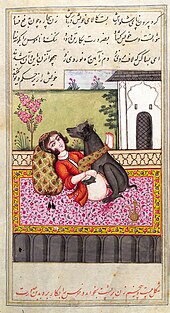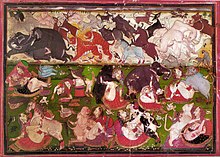Zoophilia is a paraphilia in which a person experiences a sexual fixation on non-human animals. Bestiality instead refers to cross-species sexual activity between humans and non-human animals. Due to the lack of research on the subject, it is difficult to conclude how prevalent bestiality is. Zoophilia, however, was estimated in one study to be prevalent in 2% of the population in 2021.
History
The historical perspective on zoophilia and bestiality varies greatly, from the prehistoric era, where depictions of bestiality appear in European rock art, to the Middle Ages, where bestiality was met with execution. In many parts of the world, bestiality is illegal under animal abuse laws or laws dealing with sodomy or crimes against nature.
Terminology
General
Three key terms commonly used in regards to the subject—zoophilia, bestiality, and zoosexuality—are often used somewhat interchangeably. Some researchers distinguish between zoophilia (as a persistent sexual interest in animals) and bestiality (as sexual acts with animals), because bestiality is often not driven by a sexual preference for animals. Some studies have found a preference for animals is rare among people who engage in sexual contact with animals.
Furthermore, some zoophiles report they have never had sexual contact with an animal. People with zoophilia are known as “zoophiles”, though also sometimes as “zoosexuals”, or even very simply “zoos”. Zooerasty, sodomy, and zooerastia are other terms closely related to the subject but are less synonymous with the former terms, and are seldom used. “Bestiosexuality” was discussed briefly by Allen (1979), but never became widely established. Ernest Bornemann coined the separate term zoosadism for those who derive pleasure – sexual or otherwise – from inflicting pain on animals. Zoosadism specifically is one member of the Macdonald triad of precursors to sociopathic behavior.
Zoophilia

The term zoophilia was introduced into the field of research on sexuality in Psychopathia Sexualis (1886) by Krafft-Ebing, who described a number of cases of “violation of animals (bestiality)”, as well as “zoophilia erotica”, which he defined as a sexual attraction to animal skin or fur. The term zoophilia derives from the combination of two nouns in Greek: ζῷον (zṓion, meaning “animal”) and φιλία (philia, meaning “(fraternal) love”).
In general contemporary usage, the term zoophilia may refer to sexual activity between human and non-human animals, the desire to engage in such, or to the specific paraphilia (i.e., the atypical arousal) which indicates a definite preference for animals over humans as sexual partners. Although Krafft-Ebing also coined the term zooerasty for the paraphilia of exclusive sexual attraction to animals, that term has fallen out of general use.
Zoosexuality
The term zoosexual was proposed by Hani Miletski in 2002 as a value-neutral term. Usage of zoosexual as a noun (in reference to a person) is synonymous with zoophile, while the adjectival form of the word – as, for instance, in the phrase “zoosexual act” – may indicate sexual activity between a human and an animal. The derivative noun “zoosexuality” is sometimes used by self-identified zoophiles in both support groups and on internet-based discussion forums to designate sexual orientation manifesting as sexual attraction to animals.[9]
Bestiality

Some zoophiles and researchers draw a distinction between zoophilia and bestiality, using the former to describe the desire to form sexual relationships with animals, and the latter to describe the sex acts alone. Confusing the matter yet further, writing in 1962, William H. Masters used the term bestialist specifically in his discussion of zoosadism.
Stephanie LaFarge, an assistant professor of psychiatry at the New Jersey Medical School, and Director of Counseling at the ASPCA, writes that two groups can be distinguished: bestialists, who rape or abuse animals, and zoophiles, who form an emotional and sexual attachment to animals. Colin J. Williams and Martin Weinberg studied self-defined zoophiles via the internet and reported them as understanding the term zoophilia to involve concern for the animal’s welfare, pleasure, and consent, as distinct from the self-labelled zoophiles’ concept of “bestialists”, whom the zoophiles in their study defined as focused on their own gratification. Williams & Weinberg (2003) also quoted a British newspaper saying that zoophilia is a term used by “apologists” for bestiality.
Sexual arousal from watching animals mate is known as faunoiphilia.
Extent of occurrence

The Kinsey reports of 1948 and 1953 estimated the percentage of people in the general population of the United States who had at least one sexual interaction with animals as 8% for males and 5.1% for females (1.5% for pre-adolescents and 3.6% for post-adolescents females), and claimed it was 40–50% for the rural population and even higher among individuals with lower educational status.
later writers dispute the figures, noting that the study lacked a random sample in that it included a disproportionate number of prisoners, causing sampling bias. Martin Duberman has written that it is difficult to get a random sample in sexual research, but pointed out that when Paul Gebhard, Kinsey’s research successor, removed prison samples from the figures, he found the figures were not significantly changed.

By 1974, the farm population in the US had declined by 80 percent compared with 1940, reducing the opportunity to live with animals; Hunt’s 1974 study suggests that these demographic changes led to a significant change in reported occurrences of bestiality. The percentage of males who reported sexual interactions with animals in 1974 was 4.9% (1948: 8.3%), and in females in 1974 was 1.9% (1953: 3.6%). Miletski believes this is not due to a reduction in interest but merely a reduction in opportunity.
Nancy Friday‘s 1973 book on female sexuality, My Secret Garden, comprised around 190 fantasies from different women; of these, 23 involve zoophilic activity.
In one study, psychiatric patients were found to have a statistically significant higher prevalence rate (55 percent) of reported bestiality, both actual sexual contacts (45 percent) and sexual fantasy (30 percent) than the control groups of medical in-patients (10 percent) and psychiatric staff (15 percent). Crépault & Couture (1980) reported that 5.3 percent of the men they surveyed had fantasized about sexual activity with an animal during heterosexual intercourse. In a 2014 study, 3% of women and 2.2% of men reported fantasies about having sex with an animal. A 1982 study suggested that 7.5 percent of 186 university students had interacted sexually with an animal. A 2021 review estimated zoophilic behavior occurs in 2% of the general population.
Perspectives on zoophilia
Research perspectives
Zoophilia has been discussed by several sciences: psychology (the study of the human mind), sexology (a relatively new discipline primarily studying human sexuality), ethology (the study of animal behavior), and anthrozoology (the study of human–animal interactions and bonds).
In the fifth edition of the Diagnostic and Statistical Manual of Mental Disorders (DSM-5), zoophilia is placed in the classification “other specified paraphilic disorder” (“paraphilias not otherwise specified” in the DSM-III and IV). The World Health Organization takes the same position, listing a sexual preference for animals in its ICD -10 as “other disorder of sexual preference”. In the DSM-5, it rises to the level of a diagnosable disorder only when accompanied by distress or interference with normal functioning.
Zoophilia may be covered to some degree by other fields such as ethics, philosophy, law, animal rights and animal welfare. It may also be touched upon by sociology which looks both at zoosadism in examining patterns and issues related to sexual abuse and at non-sexual zoophilia in examining the role of animals as emotional support and companionship in human lives, and may fall within the scope of psychiatry if it becomes necessary to consider its significance in a clinical context. The Journal of Forensic and Legal Medicine (Vol. 18, February 2011) states that sexual contact with animals is almost never a clinically significant problem by itself; it also states that there are several kinds of zoophiles:
- Human-animal role-players
- Romantic zoophiles
- Zoophilic fantasizers
- Tactile zoophiles
- Fetishistic zoophiles
- Sadistic bestials
- Opportunistic zoophiles
- Regular zoophiles
- Exclusive zoophiles
Romantic zoophiles, zoophilic fantasizers, and regular zoophiles are the most common, while sadistic bestials and opportunistic zoophiles are the least common.
Zoophilia may reflect childhood experimentation, sexual abuse or lack of other avenues of sexual expression. Exclusive desire for animals rather than humans is considered a rare paraphilia, and they often have other paraphilias with which they present. Zoophiles will not usually seek help for their condition, and so do not come to the attention of psychiatrists for zoophilia itself.
The first detailed studies of zoophilia date prior to 1910. Peer-reviewed research into zoophilia in its own right started around 1960. However, a number of the most oft-quoted studies, such as Miletski, were not published in peer-reviewed journals. There have been several significant modern books, from psychologists William H. Masters (1962) to Andrea Beetz (2002); their research arrived at the following conclusions:
- Most zoophiles have (or have also had) long term human relationships as well or at the same time as bestial ones, and that bestial partners are usually dogs and/or horses.
- Zoophiles’ emotions and care for animals can be real, relational, authentic and (within animals’ abilities) reciprocal, and not just a substitute or means of expression. Beetz believes zoophilia is not an inclination which is chosen.
- Society in general is considerably misinformed about zoophilia, its stereotypes, and its meaning. The distinction between zoophilia and zoosadism is a critical one to these researchers, and is highlighted by each of these studies. Masters (1962), Miletski (1999) and Weinberg (2003) each comment significantly on the social harm caused by misunderstandings regarding zoophilia: “This destroy[s] the lives of many citizens”.
More recently, research has engaged three further directions: the speculation that at least some animals seem to enjoy a zoophilic relationship assuming sadism is not present, and can form an affectionate bond.
Beetz described the phenomenon of zoophilia/bestiality as being somewhere between crime, paraphilia and love, although she says that most research has been based on criminological reports, so the cases have frequently involved violence and psychiatric illness. She says only a few recent studies have taken data from volunteers in the community. As with all volunteer surveys and sexual ones in particular, these studies have a potential for self-selection bias.
Medical research suggests that some zoophiles only become aroused by a specific species (such as horses), some zoophiles become aroused by multiple species (which may or may not include humans), and some zoophiles are not attracted to humans at all.[7][42]
Historical and cultural perspectives

Instances of zoophilia and bestiality have been found in the Bible, but the earliest depictions of bestiality have been found in a cave painting from at least 8000 BC in the Northern Italian Val Camonica a man is shown about to penetrate an animal. Raymond Christinger interprets the cave painting as a show of power of a tribal chief, it is unknown if this practice was then more acceptable, and if the scene depicted was usual or unusual or whether it was symbolic or imaginary.
According to the Cambridge Illustrated History of Prehistoric Art, the penetrating man seems to be waving cheerfully with his hand at the same time. Potters of the same time period seem to have spent time depicting the practice, but this may be because they found the idea amusing. The anthropologist Dr “Jacobus X”, said that the cave paintings occurred “before any known taboos against sex with animals existed”. William H. Masters claimed that “since pre-historic man is prehistoric it goes without saying that we know little of his sexual behavior”; depictions in cave paintings may only show the artist’s subjective preoccupations or thoughts.
Pindar, Herodotus, and Plutarch claimed the Egyptians engaged in ritual congress with goats. Such claims about other cultures do not necessarily reflect anything about which the author had evidence, but may be a form of propaganda or xenophobia, similar to blood libel.
Several cultures built temples (Khajuraho, India) or other structures (Sagaholm, barrow, Sweden) with zoophilic carvings on the exterior, however at Khajuraho, these depictions are not on the interior, perhaps depicting that these are things that belong to the profane world rather than the spiritual world, and thus are to be left outside.
In the Church-oriented culture of the Middle Ages, zoophilic activity was met with execution, typically burning, and death to the animals involved either the same way or by hanging, as “both a violation of Biblical edicts and a degradation of man as a spiritual being rather than one that is purely animal and carnal”. Some witches were accused of having congress with the devil in the form of an animal. As with all accusations and confessions extracted under torture in the witch trials in Early Modern Europe, their validity cannot be ascertained.
Religious perspectives
Passages in Leviticus 18 (Lev 18:23: “And you shall not lie with any beast and defile yourself with it, neither shall any woman give herself to a beast to lie with it: it is a perversion.” RSV) and 20:15–16 (“If a man lies with a beast, he shall be put to death; and you shall kill the beast. If a woman approaches any beast and lies with it, you shall kill the woman and the beast; they shall be put to death, their blood is upon them.” RSV) are cited by Jewish, Christian, and Muslim theologians as categorical denunciation of bestiality. However, the teachings of the New Testament have been interpreted by some as not expressly forbidding bestiality.
In Part II of his Summa Theologica, medieval philosopher Thomas Aquinas ranked various “unnatural vices” (sex acts resulting in “venereal pleasure” rather than procreation) by degrees of sinfulness, concluding that “the most grievous is the sin of bestiality”. Some Christian theologians extend Matthew’s view that even having thoughts of adultery is sinful to imply that thoughts of committing bestial acts are likewise sinful.

There are a few references in Hindu temples to figures engaging in symbolic sexual activity with animals such as explicit depictions of people having sex with animals included amongst the thousands of sculptures of “Life events” on the exterior of the temple complex at Khajuraho. The depictions are largely symbolic depictions of the sexualization of some animals and are not meant to be taken literally.
According to the Hindu tradition of erotic painting and sculpture, having sex with an animal is believed to be actually a human having sex with a god incarnated in the form of an animal. However, in some Hindu scriptures, such as the Bhagavata Purana and the Devi Bhagavata Purana, having sex with animals, especially the cow, leads one to hell, where one is tormented by having one’s body rubbed on trees with razor-sharp thorns. Similarly, the Manusmriti in verse 11.173 also condemns the act of bestiality and prescribes punishments for it.